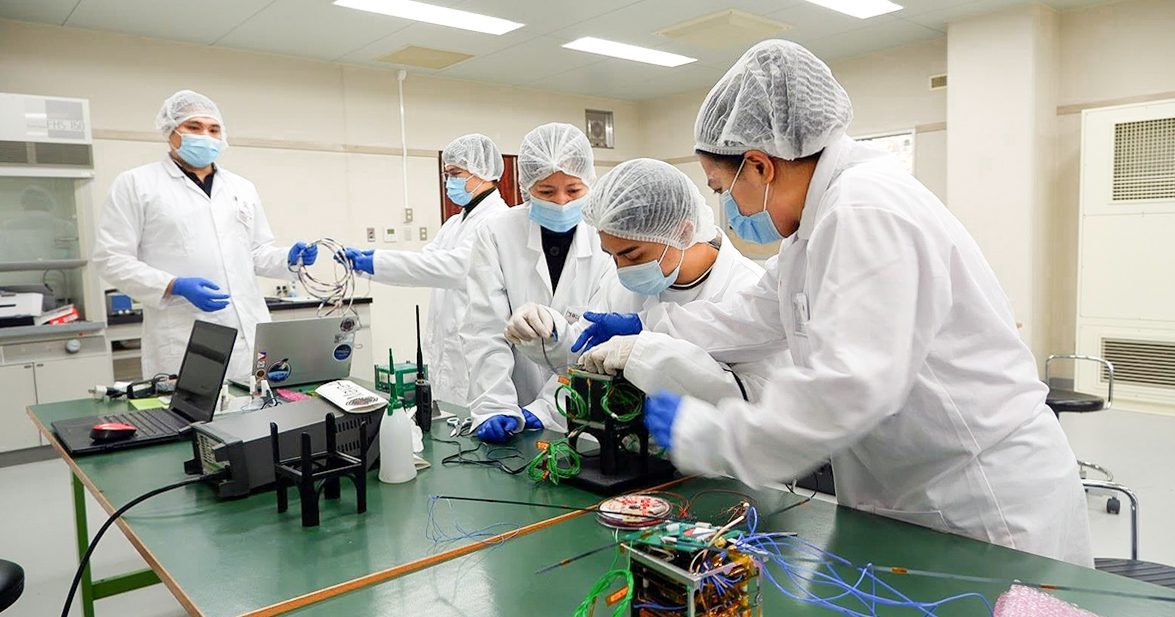
A De La Salle Lipa (DLSL) alumnus was one of the engineers and scientists behind a significant milestone for the Philippine satellite development field.
Judiel Reyes, an electronics and communications engineering graduate from DLSL, participated in constructing the Maya-3 and Maya-4, the country’s first locally built nanosatellites, also known as Cube Satellites that were launched to the International Space Station (ISS) last Aug. 29.
In an interview with Reyes, he mentioned that nanosatellites were cheaper to conduct experiments in outer space because their parts were similar to those of the bigger satellite models.
This first PH university-built satellites were made possible along with seven other Filipino engineers and scientists and their continuous efforts and hard work in leveraging the country’s space science technology.

Building the first Filipino-made satellites
After graduating from DLSL, Reyes passed the Electronics Engineering Licensure Examination and worked for ROHM LSI Design Philippines Inc., a company that manufactures semiconductors.
However, Reyes had to give up his two-year job to be one of the Filipino scholars building nanosatellites in the country.
The opportunity was under the Space Science and Technology Proliferation through University Partnerships (STeP-UP) project, a graduate program in the University of the Philippines (UP) Diliman Electrical and Electronics Engineering Institute, which offers a nano-satellite engineering track.
“Parang once in a lifetime opportunity lang ‘yung mabigyan ka ng scholarship and magbi-build ka ng satellite, so tinake ko na ‘yun,” said Reyes.
In 2019, their team began to lay plans for nanosatellites Maya-3 and Maya-4, which included different phases such as the Mission Definition Review (MDR), Preliminary Design Review (PDF), and lastly, the Critical Design Review (CDR).
According to Reyes, MDR centers on planning, wherein they will provide proposals based on the conditions presented by the stakeholders. Once approved, they will move on to the next phase, the PDF, where they will come up with the initial design of the subsystems.
“Mayroong naka-assign sa structure, onboard computer, sa electronic systems, communications, payloads and distribution. Mayroon kaming iba’t-ibang output […] Pag na-approve na ‘don, mag po-proceed na kami sa CDR, which is magbi-build na kami ng mismong satellite,” said Reyes.
During the last phase, the satellite’s prototype will undergo multiple tests to determine if it can meet the set requirements before applying them to the actual flight model and will eventually be turned over to Japan Aerospace Exploration Agency (JAXA) for deployment.
Meanwhile, Reyes also shared that the ongoing pandemic delayed the building of Maya-3 and Maya-4.
“During lockdowns, ang hirap pumunta sa laboratories […] ‘Yung iba ay umuwi sa province [..] so ginagawa ‘yung testing remotely. Minsan hindi rin kami naku-kumpleto [dahil] mahirap talaga maka-biyahe,” Reyes said.

Their team devoted two years to building the satellites, including two months in Japan to meet fellow Filipino scientists and foreign researchers who provided knowledge and pioneered other satellites such as Maya-1, Maya-2, Diwata-1, and Diwata-2.
Reyes also mentioned that he struggled with managing his studies during the satellite-building; however, seeing its launch gave it a sense of significance.
“Actually nung simula, ‘di mo agad makikita yung significance ng ginagawa mo, since nakakulong ka lang sa laboratory. […] Pero after na-launch na nga, doon mo makikita ‘yung effect nya,” Reyes shared.
Boosting PH’s space initiatives
Maya-3 and Maya-4 were built locally to provide opportunities and independence for our country in manufacturing, testing, and providing our engineers with hands-on experiences in satellite development that would further improve the country’s space initiatives and activities.
Reyes and his team used the knowledge they gained from Japan as a stepping stone to build the satellites locally. All its specialized and standard parts would have to be provided by local manufacturers, benefiting several industries within the country.

“Kasi ‘pag dito mo ginawa yung satellite, ‘yung mga parts dito mo rin sya io-order, so ‘yung mga industry, mag bi-build sila and magkakaroon ng bagong product [and] pwede silang maging distributor,” Reyes emphasized.
On the other hand, Reyes was assigned to work on the satellite’s store and forward mission, which will enable the satellites to store and receive messages while orbiting the planet and ensure that both satellites receive and validate the transmitted signal from a ground station.
He also worked on the Maya-3 and Maya-4’s camera missions which aimed to capture images in various modes, resolutions, and qualities using a commercial-of-the-shelf (COTS) camera, which served as the eye of the satellites from space.
Both satellites also featured an onboard camera that ensures they will execute their expected functions and an electrical power subsystem that confirms that they will continuously and safely perform their mission until their battery life drains out.
*
Moreover, Reyes added that Maya-3 and Maya-4 were made possible by the Space Technology and Applications Mastery, Innovation, and Advancement (STAMINA4Space) program, which was funded by the Department of Science and Technology (DOST) and jointly implemented by the UP Diliman and the DOST-Advanced Science and Technology Institute.
STeP-UP Project Leader, Paul Jason Co, said that the success of Maya-3 and Maya-4 was achieved because of the knowledge and experience obtained from other institutions through collaboration and cooperation.
Maya-3 and Maya-4 were released to space from the International Space Station (ISS) last Oct. 6 via Japan’s Japanese Experiment (JEM), or “Kibo” Laboratory Module.
The following day after its release, Stamina4Space confirmed that the data from Maya-3 and Maya-4 were successfully received and decoded through the Philippine Universities Ground Archiving and Data Reception (PUGAD) stationed at UP Diliman.